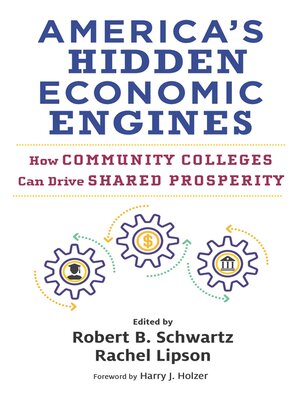America's Hidden Economic Engines
ebook ∣ How Community Colleges Can Drive Shared Prosperity · Work and Learning Series
By Robert B. Schwartz

Sign up to save your library
With an OverDrive account, you can save your favorite libraries for at-a-glance information about availability. Find out more about OverDrive accounts.
Find this title in Libby, the library reading app by OverDrive.



Search for a digital library with this title
Title found at these libraries:
| Library Name | Distance |
|---|---|
| Loading... |
Five in-depth case studies reveal the innovative practices that position U.S. community colleges as pathways to quality employment.
In America's Hidden Economic Engines, editors Robert B. Schwartz and Rachel Lipson spotlight community and technical colleges as institutions uniquely equipped to foster more equitable economic growth across America's regions. As Schwartz and Lipson show, these colleges are the best-placed institutions to reverse the decades-long rise in US economic inequality by race, class, and geography.
In the book, Harvard Project on Workforce researchers introduce detailed case studies of five institutions—Lorain County Community College in Ohio, Mississippi Gulf Coast Community College, Northern Virginia Community College, Pima Community College in Arizona, and San Jacinto Community College in Texas—that show what is possible when governments, employers, and communities invest in their community colleges' economic and workforce development mission.
These case studies reveal key institutional policies and practices, leadership behaviors, and organizational structures of successful collaborations between colleges and their regional partners in the public and private sector. Each case underscores how, although community colleges face distinct challenges based on local context, successful schools demonstrate a consistent focus on economic mobility and good jobs across all their programs and activities. In a concluding chapter, the editors champion community colleges as the most critical institutions for the future of US workforce development policy.
In America's Hidden Economic Engines, editors Robert B. Schwartz and Rachel Lipson spotlight community and technical colleges as institutions uniquely equipped to foster more equitable economic growth across America's regions. As Schwartz and Lipson show, these colleges are the best-placed institutions to reverse the decades-long rise in US economic inequality by race, class, and geography.
In the book, Harvard Project on Workforce researchers introduce detailed case studies of five institutions—Lorain County Community College in Ohio, Mississippi Gulf Coast Community College, Northern Virginia Community College, Pima Community College in Arizona, and San Jacinto Community College in Texas—that show what is possible when governments, employers, and communities invest in their community colleges' economic and workforce development mission.
These case studies reveal key institutional policies and practices, leadership behaviors, and organizational structures of successful collaborations between colleges and their regional partners in the public and private sector. Each case underscores how, although community colleges face distinct challenges based on local context, successful schools demonstrate a consistent focus on economic mobility and good jobs across all their programs and activities. In a concluding chapter, the editors champion community colleges as the most critical institutions for the future of US workforce development policy.







